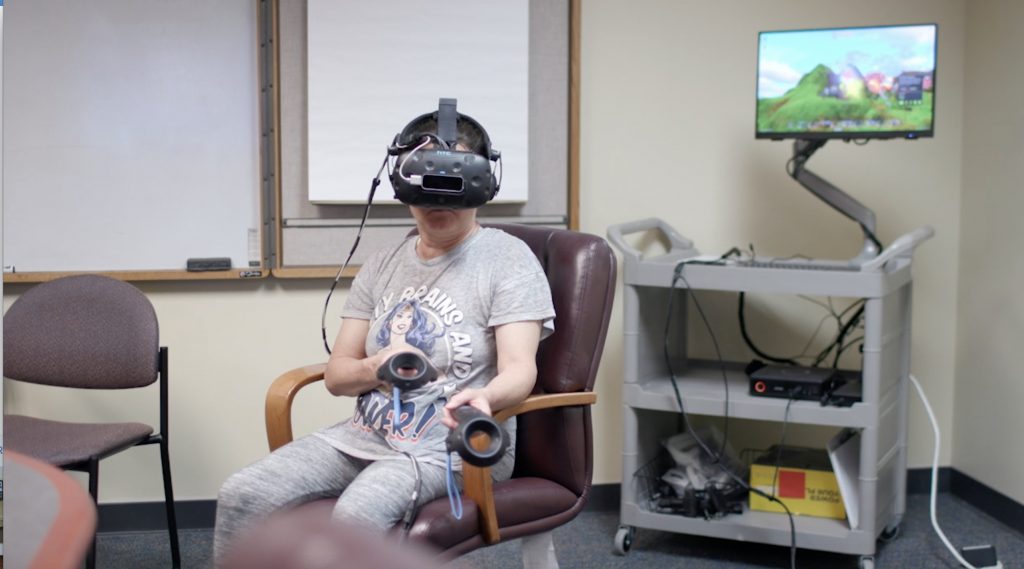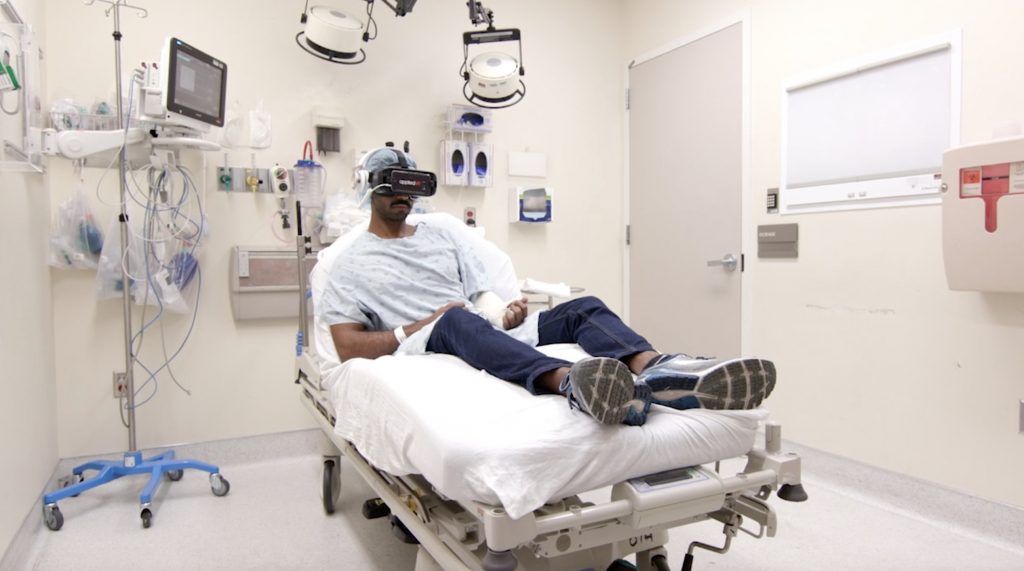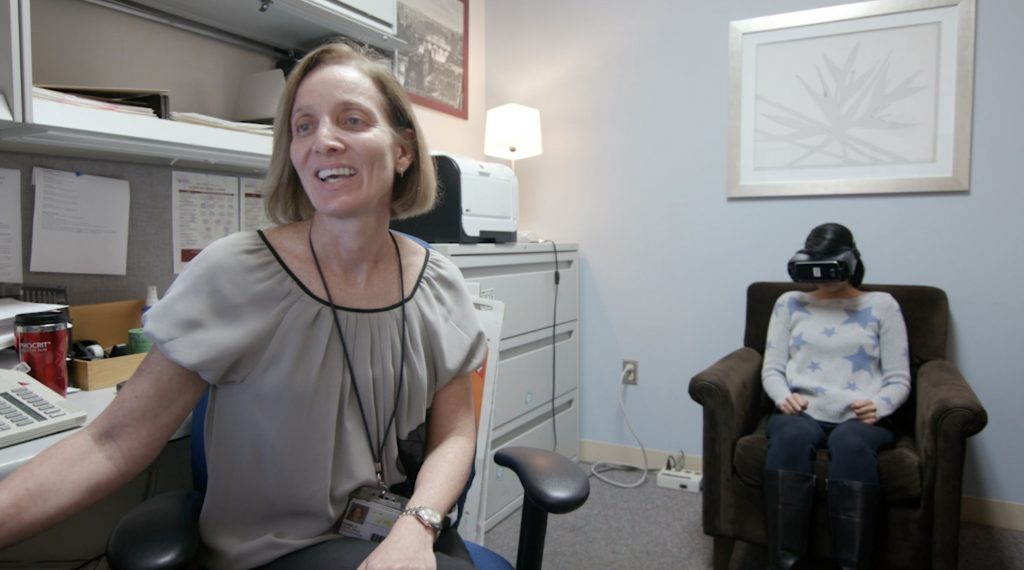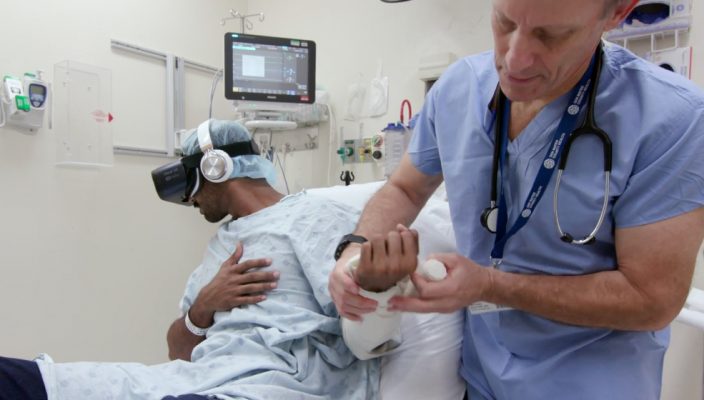Pain Management Clinic

Because researchers have been exploring VR as a therapy for pain since the late 1990s, the pain management clinic was the first home for this technology at San Mateo Medical Center. Moreover, 20 percent of US adults suffer from chronic pain — costing as much as $650 billion annually in disability programs, lost productivity, and direct medical costs — and there is a higher prevalence of chronic pain in underserved populations.
“We’re really looking at non-pharmacological modalities for managing pain, and teaching patients to utilize their internal resources and activate their own healing systems within,” said Dr. Melissa Fledderjohann, director of the pain management clinic. “And the virtual reality really taps into that. As they’re immersed in the settings, they are distracted from the pain and they have this new experience — it can teach them that by adding something new that’s not a pill or a procedure, I can reduce my pain.”
Specifically, VR is teaching patients how to manage their own pain levels through biofeedback. VR environments help patients with breathing techniques, mindfulness, and positive thinking. For instance, one immersive simulation places you in a moonlight jungle, where you’re counting and collecting fireflies; it helps you relax by linking your heart rate to your success — the calmer you are, the more fireflies you can gather.
Before putting on a VR headset, clinic staff ask patients to rate their pain levels on a scale from 0 to 10. Immediately after a 30-minute VR session, a majority of these patients will report lower pain scores.
“When I arrived here my pain level was an eight,” said Elisabeth Rooney, who uses VR weekly to alleviate the pain from spinal stenosis. “After I did the VR, it went down to a five. I love it. It’s great. It calms my nerves down, it calms my muscles down to where I can just go and breathe, and I can walk.”
Rooney loves to escape to virtual world full of cute otters. As you float down a river, tossing bubbles to the otters, the time and seasons respond to your mood, relieving stress.
Lessons Learned:
- Schedule at least 30 minutes for a VR session: 5 minutes to deploy, 20 minutes for the VR experience, and 5 minutes to takedown the equipment.
- VR with biofeedback makes patients curious about the physiology.
- Be transparent about what patients should expect from the VR experience ahead of time and warn them of any startling events. Certain elements can trigger adverse reactions depending on their history of trauma (e.g., tunnels, dark environments, an object suddenly popping in their field of view).
- Some patients think the VR tracking sensors are cameras, so they need to reassured they aren’t being recorded.
- Guarantee the patient can hear you during the VR experience. If you don’t have a direct input to their audio channel, lift one of the earpieces away from their ear so they can hear you.
Emergency Department

Next, Aratow introduced VR into the emergency department, where he also works. Doctors can now order VR goggles as easily as they can order medication.
VR acts as a distraction for patients undergoing painful procedures — patients engage their minds, while the staff attend to their bodies.
For example, the ED received a pediatric patient who needed stitches on her leg. The laceration was large. Staff knew the procedure would take longer to complete, potentially extending the patient’s anxiety and increasing the likelihood that the medicine’s numbing effect would start to wear off. So they introduced the patient to a VR game where you shoot little beach balls at cartoon bears. During the procedure, the patient felt some discomfort and started to cry. But at the same time, she was so engaged in the VR game that when the doctor asked if she wanted to stop, she said, “No, no, just keep going.” Even though she could perceive the pain, it was somewhat altered because of the game.
“That is what we call cognitive loading and so because they’re using the processing power of the brain to do that, not as much processing power is devoted to feeling the pain,” said Aratow.
Integrated Behavioral Health Clinic

Finally, VR moved into the integrated behavioral health clinic, where it’s broadened the array of psychological services the staff can offer to patients with serious anxiety disorders and phobias.
“We’re able to not only offer exposure therapy, an evidence-based treatment, but we’re also able to augment that with very real stimuli that we can put in front of the patients to get them habituated to their fears, to get the over what’s holding them back, and to really put them in the right path to move forward with their lives,” said Dr. Daniele Levy, supervising psychologist for integrated behavioral health, who had been wanting to test VR in the clinic since she saw it in action at a conference.
The goal is to show patients that the “monster has no teeth,” said Levy. There are VR simulations — in English and Spanish — to help patients overcome a fear of heights, claustrophobia, and even test anxiety.
“‘Wow,’ that’s usually what we hear from our patients,” said Levy.
Recently Levy treated a woman who has been afraid to fly, but really wanted to visit her sister in New York whom she hadn’t seen in five years. The patient was scared that her airplane would fall out of the sky or something horrible would happen. But after a few VR sessions, she recognized that those worst-case scenarios were stories she was telling herself, not the actual situation around her. One day she took off the VR goggles and said, “I can do this.” The patient was able to make the trip and reunite with her family.
But it’s a process. Levy cautions that they aren’t just taking patients with arachnophobia and putting them in VR environments where they’ll be covered in spiders.
“It’s really important to keep in mind that the technology is a tool. It’s not the treatment,” said Levy. “So to get patients prepared to use that tool, it takes a lot of rapport building, and it takes a lot of education to bring them onboard.”




